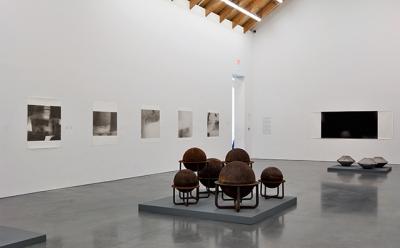Brian Gaman: Playing With Perception at the Parrish

Volume, mass, negative space. These are the words that pop into your head at the Parrish Art Museum exhibition “Brian Gaman: Vanishing Point.” Whether sculptural objects or pigment prints, the works on view play with our perception.
The show is a tidy, if not complete, survey of the artist, a Springs part-timer who died in 2014. The earlier works, dating from the mid-1980s, are sculptures in cast aluminum and bronze. They have the sense of being holdovers of Minimalist urges from prior decades, but imply visually that there is more happening than meets the eye.
An untitled assemblage of two rounded and seamed cast-aluminum pieces from 1987 is set on flat aluminum tiles and placed just outside the museum. The square tiles appear to reference Carl Andre’s floor pieces while adding the sculptor’s own riposte: two larger and more massive pieces, one that looks like two bowls set on top of each other lip to lip, the other similar but more elongated, and conical like a teardrop or maybe even a bullet. It is as if he made them to say, “No, sculpture doesn’t have to just lie on the floor or the ground. There can be something more than that.”
Inside, the Parrish mixes an installation of spheres made from iron, aluminum, and steel, with a grouping of wok-like flying saucer shapes and a glass and steel piece that references eyeglasses. These allusions are important, marking a departure from the purely Formalist aims of previous generations. They describe, but not quite represent, objects that we can recognized but leave us unsure of what, exactly, we are seeing. He generalizes the specific, with the understanding that the mind will fill in the blanks when necessary, taking what little or large bytes of information are offered, sorting and cross-referencing them to perceive the resulting whole.
Like Picasso’s “Guitar” sculptures, which seemed so radical at the time of their making, these works take perception of an abstract idea for granted. Both use very limited visual language to represent known forms. Almost a century removed from Gaman, however, the artists of Picasso’s era were still tied to more descriptive means of portraying the referenced object, so that untrained eyes could make the connection. If the Cubists had been too abstract, no one could have appreciated their achievement. As abstraction became non-objective in later decades, culminating in both Abstract Expressionism and Minimalism, it cleared the way for an artist like Gaman to synthesize these impulses into his own creative patois.
He continued this endeavor in his digital pigment prints, large-scale, mostly colorless renderings of objects taken far from their original form by a process of refocusing still images from earlier videos, and taking them, for the most part, past anything recognizable. The works on view start with a series of bottle scans from the early 2000s. These prints hint at their source, but it is difficult to imagine that one would know it if not prompted by the titles. One of them seems to include a portion of a female face, and there are other allusions, but my guess is that these are personal readings, as if they function more as Rorschach tests than universal observations.
A series of single discs on white backgrounds refer more faithfully to their Minimalist ancestors and are followed by what look like blurred graffiti tags, moody landscapes, wind or water ripples in sand, or pure dark atmosphere. Expanses of white space seem part of the overall composition. Like pentimenti or marginalia, little thumbnails of imagery show up in certain works. They seem to function as a place to refocus the eyes when the images’ expansiveness becomes too overwhelming.
The single insertion of an all-red abstraction, itself placed in the midst of a towering seven-foot-high sheet of paper, appears to serve a similar function. The single blip of color becomes a blast of high-octane energy, drawing most of the room’s attention toward it. It is as if all of the white, black, gray, and oxidized brown objects in the room are placed there merely to offer a counterbalance, and not the other way around. It’s one more way this work forces viewers to reassess how they take in and reconcile visual stimulus.
It’s an effect that stays with them long after they’ve left the museum, but it can only be experienced through Sunday.
